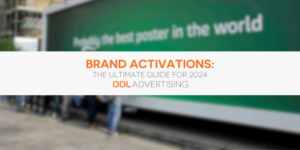

Overview.
It’s starting to happen. That feeling you get at the end of the winter. The sun is out; vitamin D gives you that ✨serotonin✨. Driving with the windows down – “Levels” by Avicii plays softly in the distance (okay, that one might be just us). Generally, your mood is stellar, and you have a little extra pep in your step. What’s going on? It’s not the planets affecting your zodiac chart, and it’s certainly not the wish you made at 11:11; it’s the weather.
According to research, warmer weather has a direct correlation with our moods.
Moreover, this change in mood is shown to directly affect consumers’ willingness to take financial risks. That’s marketing jargon for the weather directly and indirectly affecting marketing efforts. To understand these financial risks precisely, we must learn more about how weather can alter our moods, so let’s get into it.
How Does Weather Effect our Mood?
Have you ever felt more sluggish in the winter or gotten stressed just before a big storm? Similarly, maybe find yourself getting irritable in the heat, or enjoying a memory boost on a pleasant sunny day. All of these changes in mood have been attributed to significant weather patterns. Throngs of studies discuss all the different ways weather impacts our brain chemistry. Some of the most notable include the discovery of Seasonal Affective Disorder, or SAD, a type of seasonal depression that intensifies in the colder winter months.
Of course, humans are different, but according to a 2011 study, most people fall into one of these four categories when it comes to their “feelings” about the weather:
- Summer lovers: Your mood improves in warm and sunny weather.
- Summer haters: Your mood declines in warm and sunny weather.
- Rain haters: Your mood declines on rainy days.
- Unaffected: Weather doesn’t affect your mood much.
These results are not super noteworthy as you likely know someone who falls into each category: a beach Bum, a snow bunny, and the other two. What is interesting about these categories is that they can be passed down generationally. That’s right, your family generics can determine which type of weather you prefer. In that same 2011 study, it was identified “that intergenerational concordance effects were found for two of these types, suggesting that weather reactivity may run in the family.” So not only do you have a proclivity for a specific type of weather, but your entire family is likely to do as well.

Understanding the four types of weather groupings, there exists some general assumptions about weather patterns and what constitutes a spike or dip in your mood. Another study determined more adverse weather conditions create “low mood” while consistent homeostatic weather contributed to “high mood” experiences.
Gee, all this sounds like another day in science class, but how does it affect our decision to take financial risk?
Don’t worry; we’re getting to that.
These results are not super noteworthy as you likely know someone who falls into each category: a beach Bum, a snow bunny, and the other two. What is interesting about these categories is that they can be passed down generationally. That’s right, your family generics can determine which type of weather you prefer. In that same 2011 study, it was identified “that intergenerational concordance effects were found for two of these types, suggesting that weather reactivity may run in the family.” So not only do you have a proclivity for a specific type of weather, but your entire family is likely to do as well.

Understanding the four types of weather groupings, there exists some general assumptions about weather patterns and what constitutes a spike or dip in your mood. Another study determined more adverse weather conditions create “low mood” while consistent homeostatic weather contributed to “high mood” experiences.
Gee, all this sounds like another day in science class, but how does it affect our decision to take financial risk?
Don’t worry; we’re getting to that.
How Weather Affects our Ability to Take Financial Risk:
With these weather characteristics grouped into “high and low” moods, it’s relatively simple to determine what type of weather makes humans more likely to take a risk. Rather than linking another study that backs up the claim that warmer weather and increased financial risk taking go hand in hand, let’s use an Instagram reel.
If you’ve EVER felt the 70 degree weather hit your skin after a day of work, you know you immediately need to be sipping sangria on a patio or rooftop. If you have never felt this, you’re a liar and I don’t trust you.
In all seriousness, studies have shown that warmer weather renders people more willing to make big purchases. This is due to the increase of serotonin generated by sunlight and the suppression of cortisol, the stress hormone that sees spikes during gloomy, colder weather.
This manifests annually when we do our spring cleaning, buy new outfits for summer events, book summer travel, or maybe even invest in a larger purchase, like a new home or car.
Caption: The Good Shark uses good weather to get people excited to shop their brand.
How Marketers Can Leverage Weather in their Campaigns:
If you’re in business, which we assume you are if you’re reading this, then you know as well as we do that seasonality, especially in New England, affects business. Property management companies make the switch between lawn care and snow removal. Restaurants experience seasonal menu changes and expand seating to outdoor dining, and fashion has followed spring and winter collection cycles for a while. Now that we’re throwing in the moodiness of humans, how do we leverage that to our benefit?

First, we have to know what lane our business is in. Not everyone is affected by seasonality, but everyone can lean into the financial leniency associated with spring. Accuweather (believe it or not) published this great graphic of some of the major weather-sensitive industries. If you’re in one of these, you’ve probably got a handle on when to hit people with certain messages, but if not. Here are some tips and examples on implementing campaigns around these risk-takers.
- Kick off the feel-good season is a relevant brand activation – we’ve got a whole blog on this.
- Have a sale
- Run some other promotion – buy one get one, gift with purchase, etc
- Introduce a loyalty program – something to get customers to make repeat purchases often
DDL knows how to deal with seasonality and the moods of increased financial risk-takers well. We see this with client budgets. More often than not, clients will cut back on spending during the winter months and start to ramp up in the weeks leading up to summer. Like traditional consumers, DDL recognizes that weather can impact their customers’ ability to make purchases, so we take care to break up their spending.
So, the next time you’re outside (yes, you have to touch grass or equivalent for this to work), start radiating good vibes. Remember a few things.
- Predisposition for weather is hereditary.
- You’re more likely to make that risky purchase – buyer beware.
- DDL is here to help bring your feel-good weather campaign to life!







